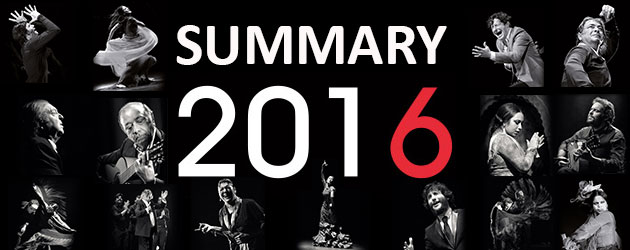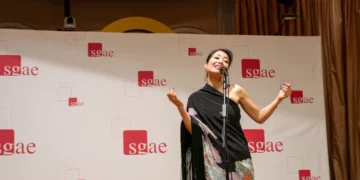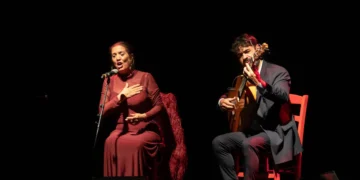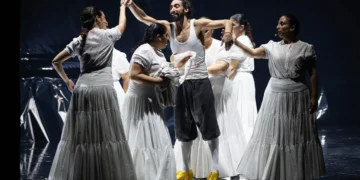DeFlamenco.com
Festivals, contests, especials, interviews, recordings, losses.
What did Flamenco bring in 2016?
Well, it depends on when we consider the question, and from what perspective. Now, just when 2016 is slipping through our fingers, we can highlight everything we’ve seen, and what we’ve written about in deflamenco.com over the course of the year, which has been considerable. Festivals we’ve attended, especially relevant news, interviews with prominent artists and also record releases worthy of note. And our inescapable duty to remember and honor losses that diminished the history of this art-form we all enjoy so much, day after day.
Festivals
As in all even-numbered year, this was a Bienal year, the Bienal de Flamenco de Sevilla, which we always cover in depth. This year noteworthy artists were Patricia Guerrero with “Catedral”, Marina Heredia, Rocío Molina, Vicente Amigo, María Terremoto, Rocío Márquez, José Valencia and the Ballet Flamenco de Andalucía. There were also some failures, the less said the better.
The Festival de Jerez in its twentieth edition, kept us busy in the usual time frame of February and March, with Manuel Liñán and Antonio Molina El Choro receiving the highest praise. Various shows commemoration the festival’s 20th anniversary were very popular, and took flamenco to a variety of venues such as plazas, markets and wineries. A chosen formula used by many other festivals, including the Bienal, and in particular the “Flamenco en los Balcones”, although not actually new, did make Pamplona a focal point in the third edition of the “Flamenco on Fire” festival.
Other important festivals of the flamenco calendar dealt with the handicap of political changes, as was the case with Festival Suma Flamenca de Madrid in its ninth edition, for the first time without director Juan Verdú, who was replaced by Aida Gómez. There were no big changes with regard to other editions, the program took few risks and managed to fill the theaters. Nothing new, except that the official photographers were not able to cover most of the shows. At the same time in Madrid, the second edition of the Flamenco Madrid festival was held, making a place for itself with new shows that significantly open the artistic and creative range.
And a big “ole!” for Madrid, in 12 long months only two large format big- budget festivals, both in the month of June. The capital’s flamenco offering is rounded out with the Ciclo Flamenco Joven, carried out in September at the Conde Duque Auditorium, all sold out, the perfect showcase for young artists wishing to present themselves in Madrid. Other noteworthy flamenco cycles include that organized by the SGAE twice a year with new proposals under the name “Flamencos y Mestizos”, managing to fill the Sala Berlanga with flamenco fans. And the tablaos which manage to maintain a high artistic level with their regular programming, most notably Corral de la Morería, now celebrating its 60th anniversary, and Casa Patas, downstairs or up in the Sala García Lorca, an intimate setting without amplification, barely 90 people each weekend enjoy the best flamenco singing, a must-see, for both artists and followers of the art.
The Cante de las Minas also withstood political changes which caused some uncertainly among festival regulars, although this did not visibly affect the event with its 56 years of history, and which, in addition to the gala shows, awards its main prizes to four artists in each edition. On this occasion, Antonia Contreras won the “Lámpara Minera”, Alfonso Aroca the prize for “Instrumentista flamenco” and Belén López the dance prize, “El Desplante”. The “Bordón Minero” went unawarded for second consecutive year.
Another important event is the Concurso Nacional de Arte Flamenco de Córdoba which every three years proclaims it “national” prizes, this year, for José Anillo in singing, Francisco Prieto “El Currito” in guitar and el Barullo in dance. With more than 170 artists registered, many of them professionals with a long artistic background, it’s clear the always controversial contests continue to be relevant in the digital age.
We were also at the France’s Festival de Nimes, where we reported on all the shows, informed of the 20th Gira del Norte 2016 – in the agenda the 2017 program can be consulted – shows of the Jueves Flamencos Cajasol and others from Flamenco Viene del Sur, also in Seville. In Barcelona, we visited the Ciutat Flamenco for Israel Galván’s show. We did a slew of summer festivals, the classics of Seville province, the Gazpacho de Morón, the Potaje Gitano de Utrera, Reunión de Cante Jondo, Festival de Cante Grande de Puente Genil, Fiesta de la Bulería de Jerez, this year with a new format. We were also at the Jueves Flamencos de Cádiz and the Viernes Flamencos de Jerez. Lastly, we collaborated with the association Flamenco en el Mundo, and we in St. Petersburg for the new edition of their festival.
Artists
It’s complicated to talk about the artists in an annual summary, each one to a greater or lesser degree participated in the flamenco year 2016, whether because of the large number of performances in festivals, new records or show premieres. Certainly some artists are more talked about, the reasons given, and many others pass unnoticed – the flamenco media spotlight is fairly limited and doesn’t always do justice.
And since we have to stick our necks out, starting with dance, it’s only fitting to highlight dancers such as Antonio El Choro who triumphed this year with his “Aviso Bayles Gitanos”, Belén López with her “Desplante” at the Cante de las Minas and Barullo, recent winner of the Nacional de Córdoba. Patricia Guerrero with “Catedral” won over the Bienal for best show, and another Guerrero, Cadiz dancer Eduardo Guerrero, is unstoppable. Rocío Molina, always on the move, reached a high point with her four hours of improvisation at the La Bienal, in addition to her new show, “Caído del Cielo”, which debuted in Paris and will be seen at the Festival de Jerez, and also in the Gira del Norte 2017. Sara Baras continues touring with “Voces” well into 2017, Eva Yerbabuena with “Apariencias”, Farruquito appeared at major festivals with his shows “En Familia” and “Improvisao”, and already debuted “Baila Moreno” at the Bienal. Antonio Canales also had his share of performances as guest artist in numerous shows. Israel Galván, Andrés Marín, Rafaela Carrasco who said goodbye to the Ballet Flamenco de Andalucía, passing the baton to Rafael Estévez, who will debut with the show “Aquel Silverio…” at the Festival de Jerez 2017.
Dance always has a guaranteed presence in these flamenco festivals, but also in tablaos. It’s a joy to see up close the current generation of young dancer at the best tablaos. We’ll be talking about tablaos throughout 2017, DeFlamenco along with Flamenco Real have visited a number of them, with the aim of giving these venues the importance they deserve in flamenco.
Speaking of tablaos, in the realm of flamenco singing, “Tablao”, the latest recording of Arcángel from 2015, has been touring through 2016 in such important venues as the Patio of the Fundación Cajasol de Sevilla, the Museo Picasso de Málaga, or even turning Madrid’s Teatro Real into an exclusive tablao. In addition to his regular formats, Arcángel is one of the most solicited voice in flamenco, just a few weeks ago he offered a fine recital at the Sala García Lorca in Madrid, along with guitarist Pepe Habichuela. Miguel Poveda, a singer who crossed flamenco frontiers, offered recitals four by four in Spain’s main cities, always managing to be sold out – he continues to be a guarantee of success, and brings flamenco to new followers. From Chiclana, Antonio Reyes, with the guitar accompaniment of Diego del Morao, had “overbooking” throughout the year, he had more performances than any other flamenco artist. Also noteworthy, Rancapino Chico, La Macanita, Jesús Méndez, El Pele, Esperanza Fernández, Argentina, etc.…regulars at the best flamenco festivals.
In guitar, the memory of Paco de Lucía continues to permeate everything, there is no new record that fails to dedicate something to the maestro from Algeciras, nor interview without some sort of reference. Although festivals are reluctant to include guitar recitals in their programs, once again Tomatito – recently awarded the Medalla de las Artes – and Vicente Amigo – Giraldillo for guitar from the Bienal – manage to tour with their shows filling theaters and winning over audiences. Rafael Riqueni had the spotlight with several concerts, and was scheduled to open the Bienal de Sevilla in what was to have been his definitive comeback, but again saw his plans frustrated due to old problems with the law. Manolo Sanlúcar also was the center of attention when he tried to reappear in Barcelona on September 1st, but was ultimately unable to comply, leading to his performance at the Bienal also being suspended.
Recordings
The recording industry is all but dead, only the multinationals continue to produce and release records now and again, and with very specific artists. The accounts just don’t add up for any of the parties concerned, so it’s the artists themselves who assume the economic burden, producing and publishing their own records as the only way to show and register their creations, either in digital or physical format, with or without crowdfunding. Alba Molina brought out her record “Alba Molina Canta a Lole y Manuel” with guitarist José Acedo, Remedios Amaya with the CD “Rompiendo el Silencio” adds another jewel to her collection and El Parrón also brought out a fine recording, “Carbón de Fragua”. From Jerez, Juanillorro and José el Mijita, French guitarist Juan Carmona with “Perla de Oriente”, a live recording, José Carlos Gómez, a guitarist from Algeciras made “Origen”, Manuel Valencia debuted with his first CD “Entre mis Manos”, José Mercé with a pop record “Doy la Cara”, Manuel Moneo “Pa mi Manué” and flamenco instrumentalist Diego Villegas with “Bajo de Guía” dedicated to Sanlúcar de Barrameda. The year 2016 was also a year of rereleases of old recordings such as “Los Chiquitos de Algeciras” and the 4 CDs of recordings from the Corral de la Moreria to commemorate its 60th anniversary. From the multinationals, Michel Camilo & Tomatito with “Spain Forever” and Diego el Cigala with his salsa record “Indestructible” currently being presented throughout the world. But there was much more…new releases, reeditions, compilations, etc. It’s hard to include many thing in our online shop, in the digital world we live in, physical distribution is very limited, but even so, we try to keep a large catalogue of great flamenco records of our time and always.
Losses
We began the year 2016 mourning the passing of the great Manuel Agujetas who left us on Christmas day 2015, and in January, investigator Pierre Lefranc died in Tours, France, we spoke of his work and the legacy he left us. And the fateful summer of 2016, the maestro Juan Habichuela said the last goodbye on June 30th, a man who was the symbol of flamenco accompaniment guitar. Barely thirteen days later, and it was Juan Peña “El Lebrijano” at the age of 75, leaving the city of Lebrija and the world of flamenco orphaned. But apparently that wasn’t enough, and on July 30th the voice of José Menese Escot, jondo warrior and icon of Puebla de Cazalla was forever silenced. Juana la del Revuelo left us in the month of June, Jaén singer Charo López, in August, Triana singer Paco Taranto, at the beginning of September, from Utrera, Pepa de Benito, in November and Seville guitarist Ramón Amador laid down his instrument at just 61 this month of December.
For 2017
Don’t pass up the chance to enjoy flamenco whenever you can, at peñas, theaters, festivals, from balconies, in plazas, gardens and tablao, live or digitally. We are privileged to be able to live it up close day in and day out, and in as much as it is possible, we’ll keep you informed. But don’t take people’s word for it, go out and see it for yourself and have a great time.
Thank you to all our readers for following us yet another year, and our best wishes for 2017.
Descubre más desde Revista DeFlamenco.com
Suscríbete y recibe las últimas entradas en tu correo electrónico.




























